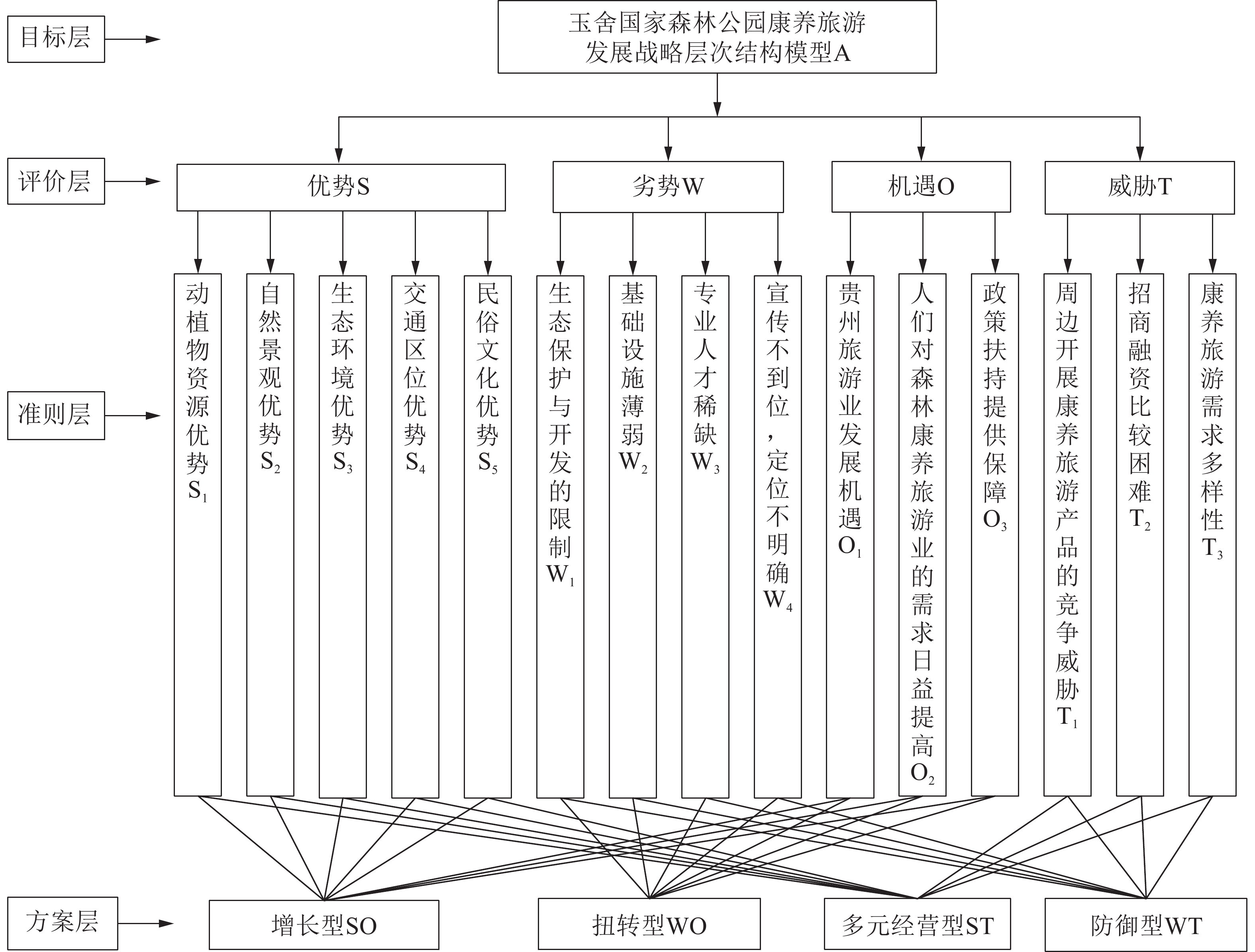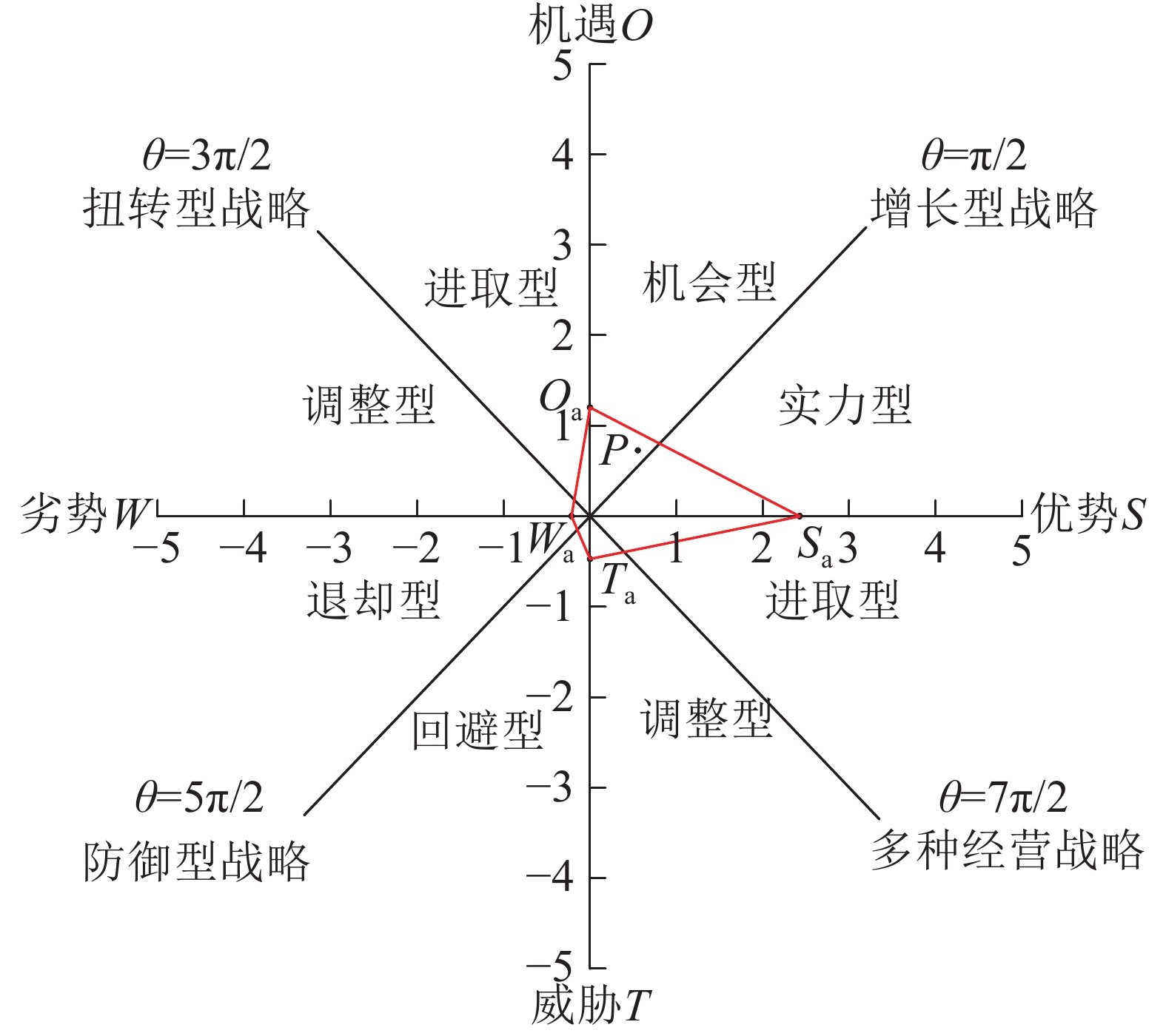-
康养旅游作为一种新兴的旅游产业,将成为未来旅游业发展的主旋律。《国家康养旅游示范基地标准》将康养旅游定义为通过养颜健体、营养膳食、修心养性、关爱环境等各种手段,使人在身体、心智和精神上都能达到自然和谐的优良状态的各种旅游活动的总和。中国森林康养目前还处于探索起步阶段,贵州以建设“全国森林康养胜地(基地)”为目标,提出力争到2020年建成森林康养基地100处,年服务5 000万人次[1]。目前,中国森林公园康养旅游的发展尚未形成一个可供参考的体系,都是在自身实际情况基础上进行探索式发展。对于森林公园发展旅游方面的研究主要集中在对森林公园的旅游资源评价、景观规划研究、旅游产品质量、旅游服务质量、旅游资源分类、公园建设评价体系等方面[2-7],而优势、劣势、机会和威胁(strengths,weaknesses,opportunities,threats,SWOT)分析方法在旅游方面广泛应用于城市战略规划、生态旅游、运动旅游、探险旅游、文化旅游等领域[8-11],并且大多是定性分析,随意性和主观性大。本研究以贵州省六盘水市玉舍国家森林公园为研究对象,构建其康养旅游可持续发展的SWOT-层次分析(AHP)模型,定量分析玉舍国家森林公园开发康养旅游的优势、劣势、机遇和威胁,并根据分析结果提出适合玉舍国家森林公园康养旅游可持续发展战略及对策。
-
六盘水市地处贵州省西部的乌蒙山区,历史悠久,文化丰富,自然景观多姿多彩,民间文俗底蕴深厚,是新兴旅游度假目的地。六盘水旅游资源非常丰富,境内有玉舍国家森林公园、乌蒙山国家地质公园、明湖国家湿地公园、月亮河夜郎布依文化生态园等景点。全市森林覆盖率为48.5%,生物多样性保存完好,境内药用植物1 512种,其中国家一级、二级保护植物73种,有水杉Metasequoia glyptostroboides、秃杉Taiwania flousiana等国家一级保护树种和银杏Gingkgo biloba、珙桐Davidia involucrata、红豆杉Taxus chinensis等国家二级保护树种,被誉为中国野生猕猴桃之乡、中国红豆杉之乡、中国野生刺梨之乡[12]。
玉舍国家森林公园位于水城县南部,26°27.508′~26°27.881′N,104°47.813′~104°50.385′E,地处低纬度、高海拔的亚热带大斜坡地带,海拔1 700~2 503 m,相对高差达803 m[12],立体气候明显,冬冷夏凉,云雾多,雨日多,日照少,空气湿度大,总面积3 342 hm2,已规划面积800 hm2,有林面积2 712 hm2,有20 hm2保存完好的原始林,有“西南林海”之称。
-
康养旅游以森林公园内部的风景资源为依托,从旅游者“身”“心”两方面着手,更倾向于“养眼”“养生”“养心”,以健康养生为主要目的。赵庆等[13]研究了不同林分不同时间段对人体康养效果的不同,提出了林分保健功能分析方法,为森林康养的建设规划提供了科学依据。在分析玉舍国家森林公园康养旅游SWOT影响因素时,公园自身的资源、景观、环境、交通等因素是发展康养旅游必要的基础条件。罗芬等[14]研究发现:人们对森林旅游解说信息的需求存在差异,而康养旅游需要配备更加专业、多元的服务人员,基础服务设施建设情况、自身目标定位是否明确等内部影响因素是决定能否提供游客“养生”“养心”的潜在条件。贵州康养旅游业发展机遇,地方政策对发展康养旅游的扶持,人们对康养的需求以及康养需求的多样性,周边康养旅游景点的威胁等外部影响因素也在很大程度上影响了康养旅游的发展。
-
玉舍国家森林公园有六盘水市境内唯一保存较为完好的原始天然森林植被。境内植物资源丰富,森林郁闭度为0.82~0.96,人工林、天然林交错分布,植物种类多达1 000余种。此外,公园内还有国家保护动物香獐Moschus moschiferus、白腹锦鸡Chrysolophus amherstiae、红腹锦鸡Chrysolophus pictus、小灵猫Viverricula indica等。
-
玉舍国家森林公园由森林游览区、森林游乐园、森林生态保护区、综合服务区、森林探险区、发展区等6个景区组成,景区以森林及溪水景观为主要特征,还有一条“古驿道”,是当时连接云南、四川和贵州的通道。景区内有天然草场、实弹射击场、栓马场、夜郎湖、樱花林、紫杉园药浴、梅花林、夜郎谷等著名景点,还有目前中国纬度最低的冬季高山滑雪场,解决了冬季旅游淡季的问题。
-
玉舍国家森林公园境内山系地形复杂,小气候条件多样,年平均气温在12.0 ℃左右,最热月平均气温24.1 ℃,最冷月平均气温−0.3 ℃,绝对最低气温−12.2 ℃,年降水量1 379.1 mm,月最大降水量291.1 mm,活动积温为3 391.1 ℃,≥10 ℃的天数为204 d,属省内少有的温凉湿润区[12]。
-
六盘水市地处川滇黔桂结合部,与周边几个省会城市的直线距离均在500 km以内,素有“四省立交桥”之称,是66个区域流通节点城市和全国196个公路交通枢纽城市之一,贵昆、南昆、内昆、水红铁路在此交汇,沪昆、杭瑞、都香、水盘等高速公路穿境而过,六盘水月照机场建成通航。随着立体交通体系的不断完善,六盘水的区位优势将更加凸显。玉舍国家森林公园位于六盘水市水城县南部,属乌蒙山支脉,地处珠江水系上游,与水城县玉舍、勺米、杨梅、米箩四乡接壤,距六盘水市中心30 km,区位优越,交通便利,有水柏铁路和两水线可到达景区,客源市场丰富。
-
六盘水市民俗文化多元,有神秘的古夜郎文化、长征文化、“三线”精神等。居住的彝、苗、布依等38个民族,孕育了农耕文化、服饰文化、婚俗文化、歌舞文化等多姿多彩的民族民间文化[14]。
-
贵州省旅游条例第3条明确指出:“发展旅游业应当坚守发展和生态2条底线,突出多彩贵州山地公园特色,实行政府引导、社会参与、市场运作,推进全域旅游,坚持与多元文化保护传承、生态环境保护、城镇化进程相结合,实现生态、经济、社会效益的统一”。在玉舍森林公园内部开展康养旅游在一定程度上会对生态系统造成威胁,如过度开发旅游资源也会造成生态环境的恶化以及旅游资源的破坏,同时对生态物种的多样性也会造成威胁,所以该地区康养旅游的开发必会受到相应法律法规的限制。因此,玉舍国家森林公园生态系统的易破坏性及脆弱性也成为发展康养旅游的最大劣势。
-
森林康养旅游作为一个复合旅游方式,必然离不开与其紧密相关的交通、住宿、餐饮、产品等各种设施和服务。玉舍国家森林公园所属的玉舍镇总体接待能力较弱,服务设施不尽完善,旅游基础设施比较落后。旅游专项经费的缺乏,景点建设很难得到全面的改进,各项基础设施及服务质量有待进一步提高,这也导致了其功能难以充分发挥。
-
森林讲解员、森林引导员、自然体验师等是人们体验森林康养旅游的关键,他们可以对人们进行森林教育并引导人们进行森林体验活动,所以森林康养专业人才的缺失是发展森林康养、森林教育的突出问题之一[15]。玉舍国家森林公园由于技术力量不足,技术队伍参差不齐,不能满足康养旅游的需要。
-
知名度决定了一个旅游景区的发展前景。玉舍国家森林公园冬季高山滑雪场在全国知名度不高,吸引的只是周边地区的游客。玉舍国家森林公园内丰富的康养旅游资源,并未形成针对性的康养项目,旅游产品太单一,还停留在走马观花的旅游方式,没有对游客有强吸引力的具有养身休闲作用的康养旅游产品。缺乏强有效的康养旅游项目品牌,不能给游客鲜明的康养旅游品牌形象。
-
近年来,针对消费者对健康养生的多元化需求以及“绿水青山就是金山银山”的理念,国家层面多个部门自2016年以来陆续发布了康养旅游、森林养生等相关康养旅游政策,其中《林业发展“十三五”规划》重点强调大力发展森林康养和养老产业,构建以森林公园为主体的森林旅游休闲体系;《“健康中国2030”规划纲要》指出要打造具有国际竞争力的健康医疗旅游目的地,大力发展健康旅游。旅游产业成为贵州经济发展的重要支柱产业,成为调整产业结构推动贵州经济转型发展的重要抓手、决胜脱贫攻坚的有效路径、扩大对外开放的重要平台,“山地公园省、多彩贵州风”已成为贵州康养旅游的形象品牌。六盘水市通过转型发展,已成为“三池三湖六盘水,千岩万壑一凉都”康养度假生态旅游胜地,年接待游客数量达2 000万人次以上。目前,六盘水市正积极推进医、养、健、管、游、食大健康产业链全链条发展,加快建设健康养生、健康医药和健康养老基地,打造全国重要的康养胜地。
-
近年来,医学界一致认为引起成人病的主要元凶是压迫感,而森林是释放压迫感的最佳场所[16];中国工业化和城镇化步伐的加快,导致了生态环境恶化等一系列问题,城市化的生活方式也给人们带来的心理问题,森林康养能从精神层面使人放松心情;养老已成为中国面临的难题,现在的各类养老模式均存在不少问题,而森林康养将为中国的养老事业提供一条新途径。
-
贵州重视山地旅游的发展是玉舍国家森林公园开展康养旅游的有利大背景。《六盘水旅游业“十三五”发展规划(2016−2020)》明确指出:山地旅游方面,围绕打造大健康旅游目的地城市,提升凉都特色山地旅游业品牌,推进以大健康山地旅游为引领的现代服务业体系建设。近年来,国家对西部交通建设投入力度加大,贵州交通格局有了飞跃式的发展。通用航空、铁路尤其通往全国各地的高铁以及正在建设串联各市州的城际高铁环线;已在全国率先实现“县县通”高速公路;能通达所有3A旅游景区的“通乡连县”的加密路网等重要交通运输设施,都为发展森林康养旅游创造了良好的条件。
-
六盘水及周边地区旅游景点较多,玉舍国家森林公园并未处于优势地位。如安顺西秀九龙山森林康养基地,已建立了森林浴文化游、屯堡风情游、休闲度假游、野外生存游等旅游项目,是领略民族风情、享受大自然生态景观的好去处[17],该景点已打响自己的康养旅游品牌,特色突出。而玉舍国家森林公园康养旅游尚未形成康养旅游产品链,没有特色康养旅游产品。
-
玉舍国家森林公园基础设施薄弱、专业人才稀缺、定位不清晰、宣传不到位等劣势导致了景点知名度不高,吸引力不强,同时发展康养旅游项目短期内成效不可见,投资周期长并且存在诸多的不确定因素,导致了招商融资困难。
-
人们的养生需求越来越高,简单的观光式旅游已难以满足需求。具有生理医疗自然功能的森林康养旅游更加迎合了大众的需求,集生态旅游、休闲运动与健康长寿于一体的康养旅游项目,让人们能够从中体会到生命的乐趣,达到教育和修身养心的目的。需根据森林康养需求对旅游市场进行细分,满足不同消费群体的需求。
-
根据对玉舍国家森林公园康养旅游发展内外部影响因素分析,构建了玉舍国家森林公园康养旅游发展战略层次分析模型(图1)。
-
通过阅读森林康养旅游相关文献,根据玉舍国家森林公园康养旅游发展战略SWOT分析的4个因素,制定调查问卷,向林学、生态学、旅游管理等相关的专家学者进行咨询。通过电子邮件的方式发送30份问卷并有效收回28份,统计出各位专家学者对各因素的重要性评分,得出平均得分,作为判断指标重要性的参考依据。然后,比较各层次各指标的相对重要性,根据层次分析方法(AHP)中1~9比例赋值表构建各指标的判断矩阵,计算出每项指标相应的权重。通过判断一致性比率是否小于0.1来检验各层次指标是否通过一致性检验。具体如表1所示。
表 1 各因素层判断矩阵及一致性检验
Table 1. Determination matrix and consistency test for each factor layer
因素层 判断矩阵 wi λmax IC RC 一致性 评价层 ${{A}} = \left[ {\begin{array}{*{20}{c} } 1&8&3&6 \\ {1/8}&1&{1/6}&{1/3} \\ {1/3}&6&1&4 \\ {1/6}&3&{1/4}&1 \end{array} } \right]$ ${[\!\!\! {\begin{array}{*{20}{c}} {0.567\;1}&{0.049\;9}&{0.279\;5}&{0.103\;5} \end{array}}\!\!\! ]^{\rm{T}}}$ 4.146 6 0.048 9 0.054 3 通过 优势指标 ${{S}} = \left[ {\begin{array}{*{20}{c} } 1&{1/2}&{1/3}&3&4 \\ 2&1&{1/2}&2&3 \\ 3&2&1&5&6 \\ {1/3}&{1/2}&{1/5}&1&2 \\ {1/4}&{1/3}&{1/6}&{1/2}&1 \end{array} } \right]$ ${[\!\!\! {\begin{array}{*{20}{c}} {0.185\;9}&{0.224\;7}&{0.436\;3}&{0.093\;8}&{0.059\;3} \end{array}}\!\!\! ]^{\rm{T}}}$ 5.148 8 0.037 2 0.033 2 通过 劣势指标 ${{W}} = \left[ {\begin{array}{*{20}{c} } 1&{1/5}&{1/3}&{1/2} \\ 5&1&3&2 \\ 3&{1/3}&1&2 \\ 2&{1/2}&{1/2}&1 \end{array} } \right]$ ${[\!\!\! {\begin{array}{*{20}{c}} {0.087\;3}&{0.482\;7}&{0.251\;8}&{0.178\;2} \end{array}}\!\!\! ]^{\rm{T}}}$ 4.107 7 0.035 9 0.039 9 通过 机遇指标 ${{O}} = \left[ {\begin{array}{*{20}{c} } 1&2&3 \\ {1/2}&1&2 \\ {1/3}&{1/2}&1 \end{array} } \right]$ ${[\!\!\! {\begin{array}{*{20}{c}} {0.539\;0}&{0.297\;3}&{0.163\;8} \end{array}}\!\!\! ]^{\rm{T}}}$ 3.009 2 0.004 6 0.007 9 通过 威胁指标 ${{T}} = \left[ {\begin{array}{*{20}{c}} 1&2&3 \\ {1/2}&1&2 \\ {1/3}&{1/2}&1 \end{array}} \right]$ ${[\!\!\! {\begin{array}{*{20}{c}} {0.665\;1}&{0.231\;1}&{0.103\;8} \end{array}}\!\!\! ]^{\rm{T}}}$ 3.086 9 0.043 5 0.075 0 通过 说明:wi为指标权重值,T为矩阵转置,λmax为最大特征根,IC为一致性指标,RC为一致性比率 -
经过对玉舍国家森林公园康养旅游开发的各级指标权重的运算,得出了该层元素相对上一层元素的重要性,因此计算所有指标的组合权重也具有重要意义。将玉舍国家森林公园发展康养旅游对指标层各因素的有效反应程度进行评分,分值取±5~±1,“±5”依次递减分别代表反应极敏感、较敏感、敏感、轻度敏感、不敏感,优势和机会为正数,劣势和威胁为负数,然后用每个因素的组合权重乘以它的因素得分,即得到每个因素的加权分数(表2),将所有因素的加权分数相加,以得到总加权分数[18]。分值越大,代表其强度越大。
表 2 玉舍国家森林公园康养旅游开发评价指标体系组合权重及加权分数
Table 2. Combined weights and weighted scores of evaluation index system of wellness tourism development in Yushe National Forest Park
目标层 评价层 组内权重 准则层 组内权重 组合权重 因素得分 加权分数 玉舍国家森林公园康养旅游
开发评价指标体系优势S 0.567 1 动植物资源优势S1 0.185 9 0.105 4 4 0.421 7 自然景观资源优势S2 0.224 7 0.127 4 4 0.509 7 生态环境优势S3 0.436 3 0.247 4 5 1.237 1 交通区位优势S4 0.093 8 0.053 2 3 0.159 6 民俗文化优势S5 0.059 3 0.033 6 3 0.100 9 劣势W 0.049 9 生态保护与开发的限制W1 0.087 3 0.004 4 −4 −0.017 4 基础设施薄弱W2 0.482 7 0.024 1 −5 −0.120 4 专业人才稀缺W3 0.251 8 0.012 6 −4 −0.050 3 宣传不到位,定位不明确W4 0.178 2 0.008 9 −3 −0.026 7 机会O 0.279 5 贵州旅游业发展机遇O1 0.539 0 0.150 7 4 0.602 6 对森林康养旅游业的需求日益提高O2 0.297 3 0.083 1 5 0.415 5 政策扶持提供保障O3 0.163 8 0.045 8 4 0.183 1 威胁T 0.103 5 周边开展康养旅游产品的竞争威胁T1 0.665 1 0.068 8 −5 −0.344 2 招商融资比较困难T2 0.231 1 0.023 9 −4 −0.095 7 康养旅游需求多样性T3 0.103 8 0.010 7 −3 −0.032 2 -
对玉舍国家森林公园进行SWOT定性分析的基础上,通过1~9比例赋值表以及德尔菲法确定各要素的权重以及评分强度,运用层次分析法(AHP)定量分析以及四象限坐标法[19],得出:
总优势力度
$S = \sum {{{{S_i}} / {{n_{\rm{s}}}}}} = 2.429\; 0$ ,总劣势力度$W = \sum {{{{W_i}} / {{n_{\rm{w}}}}}} = - 0.214\;8$ ,总机会力度$O = \sum {{{{O_i}} / {{n_{\rm{o}}}}}} = $ 1.201 2,总威胁力度$T = \sum {{{{T_i}} / {{n_{\rm{t}}}}}} = - 0.472\;1$ 。其中:ns、nw、no、nt分别表示优势、劣势、机遇、威胁因子的总数量;Si、Wi、Oi、Ti表示第i个因素的优势力度、劣势力度、机会力度和威胁力度,i=1,2,3,$\cdots $ ,ns。 -
玉舍国家森林公园康养旅游发展战略评估矩阵图的绘制,是以总优势力度S、总机会力度O、总劣势力度W和总威胁力度T作为半轴变量,按照逆时针顺序构成四半维坐标系,分别找出4个力度对应的坐标点S、O、W、T,并顺次连接4点(图2)。对于战略评估矩阵图中重心坐标P(x, y),由公式P(x, y)
$= \left({\begin{array}{*{20}{c}} {\sum {{{{x_i}} / 4}} },\;\;{\sum {{{{y_i}} / 4}} }\end{array}}\right)$ 给出,xi和yi分别是S、W、O、T在战略四边形中的坐标[18]。可得重心坐标P(x, y)=P(0.553 6,0.729 1),由P点在图2坐标位置或者通过计算战略类型方位角θ,tgθ=y/x,其中0<θ<2π,可得θ取值范围为π/4~π/2,根据θ所在区间,确定玉舍国家森林公园发展康养旅游是属于机会型,应采取增长型战略。 -
根据战略四边形重心坐标P的位置,玉舍国家森林公园康养旅游发展可以凭借自身内部优势和外部机会开展增长型战略,但同时也要结合战略强度来确定最终的发展战略。战略强度又分为战略正强度和战略负强度[19]。战略正强度受外部机遇和内在优势2个因素共同影响,其计算公式为U=S×O=2.917 7,其中:U为战略正强度,S和O表示总优势力度和总机遇力度[19]。战略负强度受外部威胁与内在劣势2个因素共同影响,其计算公式为:V=W×T=0.101 2,其中:V为战略负强度,W和T分别表示总劣势力度和总威胁力度[19]。战略强度系数是判断玉舍国家森林公园康养旅游发展态势的依据,其计算公式为ρ=U/(U+V)=0.966 5。其中:ρ为战略强度系数,其大小反应战略类型的实施强度,ρ取值范围为[0, 1][19]。随着战略正强度U的增大,ρ也随之增大,康养旅游战略强度增强;若战略负强度V增大,ρ随之减小,康养旅游战略强度减弱。以ρ=0.5作为临界点,当ρ>0.5时,玉舍国家森林公园康养旅游发展应采取增长型发展战略;当ρ<0.5时,应采取防御型发展战略[19]。经过计算玉舍国家森林公园发展康养旅游的战略强度系数ρ=0.966 5>0.5,所以玉舍国家森林公园康养旅游的发展应采取积极的增长型发展战略。
-
对玉舍国家森林公园康养旅游发展影响程度从大到小为优势>机会>威胁>劣势,各指标对其发展的优势、劣势、机遇和威胁的影响则各异。生态环境优势(0.247 4)是玉舍国家森林公园发展康养旅游的最大优势条件,基础设施薄弱(0.024 1)是影响森林公园发展康养旅游的主要劣势,贵州旅游业的发展机遇(0.150 7)是玉舍国家森林公园康养旅游发展的重大机遇,但也要应对来自周边康养旅游产品的挑战(0.068 8)。玉舍国家森林公园康养旅游的发展应采取积极的增长型发展战略,即依据贵州省旅游发展的政策支持与指导的外部机遇,凭借自身的动植物资源优势、自然景观资源优势、生态环境优势、交通区位优势和民俗文化优势,以保护生态优先,加强公园内部基础设施建设,培养康养专业人才,加强宣传,形成自己的康养旅游特色。
根据以上结果,本研究提出玉舍国家森林公园发展策略:①利用自身优势建立特色康养旅游基地。第一,挖掘特色森林康养项目,建立森林康养旅游基地。玉舍国家森林公园是天然氧吧,适宜旅游疗养。应积极发展森林浴、丛林穿越、森林冥想、森林漫步、森林瑜伽等康养项目,并提供数量充足、分布合理、档次合理的康养餐饮设施和住宿设施,建立森林康养旅游特色基地。第二,利用现有旅游资源,建立运动保健康养基地。利用玉舍国家森林公园现有的实弹射击场、天然草场、滑雪场作为野外拓展区,开展模拟设计游戏、滑草、滑雪等运动健身项目。第三,开发紫山庄园温泉水疗,建设温泉养生基地。温泉水疗可以作为一种医疗康复手段用来缓解疲劳、放松身心,改善身体器官功能状态,提高人们的生活质量[20]。利用玉舍国家森林公园紫山庄园内的温泉泉水,打造特色温泉小镇和多样化的温泉水疗项目。第四,发展玉舍赏花旅游,建设园艺养生基地。玉舍国家森林公园有杜鹃花海、樱花林、梅花林,建设植物专类展览园,可作为有机农产品和花卉林木供应基地,利用花卉资源的颜色、气味等引起人们的心境变化,陶冶情操,实现园艺治疗。②分阶段、有计划地开展康养旅游基础设施建设。建设初期,可以以增强景区的可进入性与吸引力为导向,重点建设景区内部的综合基础设施以及配套服务设施,以游客的基本需求为主;建设中期,结合公园自身特色,打造森林人家、森林客栈、森林温泉、养生步道等独具特色的高端康养旅游产品;建设远期,通过完善养生养老基础设施,提供独具森林康养特色的生态养老、生态保健、美体健身等医疗养生服务。③采取多举措招商引资,引进人才。充分利用国家、贵州省、六盘水市近期出台的一系列扶持政策,组织招商活动,做好项目对接,提高招商项目的对接率和成功率,争取资金支持和财政项目支持。另外,可通过校校合作、校企合作等方式,注重产学研相结合,提升康养专业人才培养质量,为康养旅游产业输送复合型高素质专业人才。④加大宣传力度。重视和利用好网络媒体和手机媒体等新兴媒体对玉舍国家森林公园进行宣传,也可通过联办康养旅游专项活动,设计游戏卡等活动加强传播。
On sustainable development of health and wellness tourism in Yushe National Forest Park based on SWOT-AHP model
-
摘要:
目的 利用SWOT-AHP模型定量分析贵州省六盘水市玉舍国家森林公园开发康养旅游的优势、劣势、机遇和威胁,提出适合其康养旅游可持续发展战略及对策。 方法 对玉舍国家森林公园发展康养旅游的优势、劣势、机遇和威胁进行定性分析,构建评价指标体系,利用层次分析法对其发展康养旅游的优势、劣势、机遇和威胁进行定量分析,确定指标权重及加权分数,通过计算玉舍国家森林公园康养旅游发展的总优势力度,绘制森林公园康养旅游发展战略四边形,确定战略四边形重心坐标P(x,y)、战略类型方位角θ和战略强度系数ρ,选择适合玉舍国家森林公园康养旅游的发展战略和战略强度。 结果 玉舍国家森林公园发展康养旅游的优势>机会>威胁>劣势,战略四边形重心坐标P(x,y)=P(0.553 6,0.729 1),战略类型方位角θ为π/4~π/2。确定玉舍国家森林公园发展康养旅游是属于机会型,应采取增长型战略;战略强度系数ρ=0.966 5>0.5,应采取正强度发展战略。 结论 玉舍国家森林公园康养旅游的发展应采取积极的增长型发展战略,生态环境优势(0.247 4)是玉舍国家森林公园发展康养旅游的最大优势条件,基础设施薄弱(0.024 1)是影响森林公园发展康养旅游的主要劣势,贵州旅游业的发展机遇(0.150 7)是玉舍国家森林公园康养旅游发展的重大机遇,但也要应对来自周边康养旅游产品的挑战(0.068 8)。图2表2参20 -
关键词:
- 森林公园 /
- 森林康养旅游 /
- SWOT-AHP分析 /
- 可持续发展
Abstract:Objective Aimed at a strategy of sustainable development for the health and wellness tourism at Yushe National Forest Park, an analysis was made of the advantages, disadvantages, opportunities and threats with SWOT-AHP model employed. Method To be specific, a qualitative analysis is first conducted to establish an evaluation index system before Analytic Hierarchy Process (AHP) was used to quantitatively analyze these factors, and to determine the weights of the indicators and the weighted scores. Afterwards, by calculating the overall strength of the development of health and wellness tourism in Yushe National Forest Park, the quadrangle was drawn of the strategy for the development of health and wellness tourism in Forest Park with the strategic quadrangle coordinate P(x, y), strategic type azimuth θ, and strategic intensity coefficient ρ determined, and a suitable development strategy and strategic intensity selected for Yushe National Forest Park. Result It was found that in developing health and wellness tourism in Yushe National Forest Park the advantages outweigh the opportunities threats and disadvantages (A>O>T>D) with P(x, y) = P (0.553 6, 0.729 1) as the strategic quadrilateral barycenter coordinate and, the strategic type azimuth θ between π/4~π/2. It was concluded that the development of health and wellness tourism in Yushe National Forest Park belonged with the opportunity type, and growth strategies with a positive intensity (the strategic strength coefficient ρ = 0.966 5>0.5) should be adopted. Conclusion In conclusion, the development of health and wellness tourism in Yushe National Forest Park should adopt a positive growth strategy. Favorable ecological and environmental conditions (0.247 4) are the biggest advantage while the weak infrastructure (0.024 1) is the main disadvantage. The favorable development of tourism in Guizhou Province(0.150 7) offers a major opportunity for the development of health and wellness tourism in Yushe National Forest Park, however, it is also faced with the challenges of other tourist products from surrounding areas (0.068 8). [Ch, 2 fig. 2 tab. 20 ref.] -
Key words:
- forest park /
- forest wellness tourism /
- SWOT-AHP analysis /
- sustainable development
-
康养旅游作为一种新兴的旅游产业,将成为未来旅游业发展的主旋律。《国家康养旅游示范基地标准》将康养旅游定义为通过养颜健体、营养膳食、修心养性、关爱环境等各种手段,使人在身体、心智和精神上都能达到自然和谐的优良状态的各种旅游活动的总和。中国森林康养目前还处于探索起步阶段,贵州以建设“全国森林康养胜地(基地)”为目标,提出力争到2020年建成森林康养基地100处,年服务5 000万人次[1]。目前,中国森林公园康养旅游的发展尚未形成一个可供参考的体系,都是在自身实际情况基础上进行探索式发展。对于森林公园发展旅游方面的研究主要集中在对森林公园的旅游资源评价、景观规划研究、旅游产品质量、旅游服务质量、旅游资源分类、公园建设评价体系等方面[2-7],而优势、劣势、机会和威胁(strengths,weaknesses,opportunities,threats,SWOT)分析方法在旅游方面广泛应用于城市战略规划、生态旅游、运动旅游、探险旅游、文化旅游等领域[8-11],并且大多是定性分析,随意性和主观性大。本研究以贵州省六盘水市玉舍国家森林公园为研究对象,构建其康养旅游可持续发展的SWOT-层次分析(AHP)模型,定量分析玉舍国家森林公园开发康养旅游的优势、劣势、机遇和威胁,并根据分析结果提出适合玉舍国家森林公园康养旅游可持续发展战略及对策。
1. 研究区概况
六盘水市地处贵州省西部的乌蒙山区,历史悠久,文化丰富,自然景观多姿多彩,民间文俗底蕴深厚,是新兴旅游度假目的地。六盘水旅游资源非常丰富,境内有玉舍国家森林公园、乌蒙山国家地质公园、明湖国家湿地公园、月亮河夜郎布依文化生态园等景点。全市森林覆盖率为48.5%,生物多样性保存完好,境内药用植物1 512种,其中国家一级、二级保护植物73种,有水杉Metasequoia glyptostroboides、秃杉Taiwania flousiana等国家一级保护树种和银杏Gingkgo biloba、珙桐Davidia involucrata、红豆杉Taxus chinensis等国家二级保护树种,被誉为中国野生猕猴桃之乡、中国红豆杉之乡、中国野生刺梨之乡[12]。
玉舍国家森林公园位于水城县南部,26°27.508′~26°27.881′N,104°47.813′~104°50.385′E,地处低纬度、高海拔的亚热带大斜坡地带,海拔1 700~2 503 m,相对高差达803 m[12],立体气候明显,冬冷夏凉,云雾多,雨日多,日照少,空气湿度大,总面积3 342 hm2,已规划面积800 hm2,有林面积2 712 hm2,有20 hm2保存完好的原始林,有“西南林海”之称。
2. SWOT因素分析
康养旅游以森林公园内部的风景资源为依托,从旅游者“身”“心”两方面着手,更倾向于“养眼”“养生”“养心”,以健康养生为主要目的。赵庆等[13]研究了不同林分不同时间段对人体康养效果的不同,提出了林分保健功能分析方法,为森林康养的建设规划提供了科学依据。在分析玉舍国家森林公园康养旅游SWOT影响因素时,公园自身的资源、景观、环境、交通等因素是发展康养旅游必要的基础条件。罗芬等[14]研究发现:人们对森林旅游解说信息的需求存在差异,而康养旅游需要配备更加专业、多元的服务人员,基础服务设施建设情况、自身目标定位是否明确等内部影响因素是决定能否提供游客“养生”“养心”的潜在条件。贵州康养旅游业发展机遇,地方政策对发展康养旅游的扶持,人们对康养的需求以及康养需求的多样性,周边康养旅游景点的威胁等外部影响因素也在很大程度上影响了康养旅游的发展。
2.1 内部优势分析
2.1.1 动植物资源优势(S1)
玉舍国家森林公园有六盘水市境内唯一保存较为完好的原始天然森林植被。境内植物资源丰富,森林郁闭度为0.82~0.96,人工林、天然林交错分布,植物种类多达1 000余种。此外,公园内还有国家保护动物香獐Moschus moschiferus、白腹锦鸡Chrysolophus amherstiae、红腹锦鸡Chrysolophus pictus、小灵猫Viverricula indica等。
2.1.2 自然景观优势(S2)
玉舍国家森林公园由森林游览区、森林游乐园、森林生态保护区、综合服务区、森林探险区、发展区等6个景区组成,景区以森林及溪水景观为主要特征,还有一条“古驿道”,是当时连接云南、四川和贵州的通道。景区内有天然草场、实弹射击场、栓马场、夜郎湖、樱花林、紫杉园药浴、梅花林、夜郎谷等著名景点,还有目前中国纬度最低的冬季高山滑雪场,解决了冬季旅游淡季的问题。
2.1.3 生态环境优势(S3)
玉舍国家森林公园境内山系地形复杂,小气候条件多样,年平均气温在12.0 ℃左右,最热月平均气温24.1 ℃,最冷月平均气温−0.3 ℃,绝对最低气温−12.2 ℃,年降水量1 379.1 mm,月最大降水量291.1 mm,活动积温为3 391.1 ℃,≥10 ℃的天数为204 d,属省内少有的温凉湿润区[12]。
2.1.4 交通区位优势(S4)
六盘水市地处川滇黔桂结合部,与周边几个省会城市的直线距离均在500 km以内,素有“四省立交桥”之称,是66个区域流通节点城市和全国196个公路交通枢纽城市之一,贵昆、南昆、内昆、水红铁路在此交汇,沪昆、杭瑞、都香、水盘等高速公路穿境而过,六盘水月照机场建成通航。随着立体交通体系的不断完善,六盘水的区位优势将更加凸显。玉舍国家森林公园位于六盘水市水城县南部,属乌蒙山支脉,地处珠江水系上游,与水城县玉舍、勺米、杨梅、米箩四乡接壤,距六盘水市中心30 km,区位优越,交通便利,有水柏铁路和两水线可到达景区,客源市场丰富。
2.1.5 民俗文化优势(S5)
六盘水市民俗文化多元,有神秘的古夜郎文化、长征文化、“三线”精神等。居住的彝、苗、布依等38个民族,孕育了农耕文化、服饰文化、婚俗文化、歌舞文化等多姿多彩的民族民间文化[14]。
2.2 内部劣势分析
2.2.1 生态保护与开发的限制(W1)
贵州省旅游条例第3条明确指出:“发展旅游业应当坚守发展和生态2条底线,突出多彩贵州山地公园特色,实行政府引导、社会参与、市场运作,推进全域旅游,坚持与多元文化保护传承、生态环境保护、城镇化进程相结合,实现生态、经济、社会效益的统一”。在玉舍森林公园内部开展康养旅游在一定程度上会对生态系统造成威胁,如过度开发旅游资源也会造成生态环境的恶化以及旅游资源的破坏,同时对生态物种的多样性也会造成威胁,所以该地区康养旅游的开发必会受到相应法律法规的限制。因此,玉舍国家森林公园生态系统的易破坏性及脆弱性也成为发展康养旅游的最大劣势。
2.2.2 基础设施薄弱(W2)
森林康养旅游作为一个复合旅游方式,必然离不开与其紧密相关的交通、住宿、餐饮、产品等各种设施和服务。玉舍国家森林公园所属的玉舍镇总体接待能力较弱,服务设施不尽完善,旅游基础设施比较落后。旅游专项经费的缺乏,景点建设很难得到全面的改进,各项基础设施及服务质量有待进一步提高,这也导致了其功能难以充分发挥。
2.2.3 专业人才稀缺(W3)
森林讲解员、森林引导员、自然体验师等是人们体验森林康养旅游的关键,他们可以对人们进行森林教育并引导人们进行森林体验活动,所以森林康养专业人才的缺失是发展森林康养、森林教育的突出问题之一[15]。玉舍国家森林公园由于技术力量不足,技术队伍参差不齐,不能满足康养旅游的需要。
2.2.4 宣传不到位,定位不明确(W4)
知名度决定了一个旅游景区的发展前景。玉舍国家森林公园冬季高山滑雪场在全国知名度不高,吸引的只是周边地区的游客。玉舍国家森林公园内丰富的康养旅游资源,并未形成针对性的康养项目,旅游产品太单一,还停留在走马观花的旅游方式,没有对游客有强吸引力的具有养身休闲作用的康养旅游产品。缺乏强有效的康养旅游项目品牌,不能给游客鲜明的康养旅游品牌形象。
2.3 外部机遇分析
2.3.1 贵州旅游业发展机遇(O1)
近年来,针对消费者对健康养生的多元化需求以及“绿水青山就是金山银山”的理念,国家层面多个部门自2016年以来陆续发布了康养旅游、森林养生等相关康养旅游政策,其中《林业发展“十三五”规划》重点强调大力发展森林康养和养老产业,构建以森林公园为主体的森林旅游休闲体系;《“健康中国2030”规划纲要》指出要打造具有国际竞争力的健康医疗旅游目的地,大力发展健康旅游。旅游产业成为贵州经济发展的重要支柱产业,成为调整产业结构推动贵州经济转型发展的重要抓手、决胜脱贫攻坚的有效路径、扩大对外开放的重要平台,“山地公园省、多彩贵州风”已成为贵州康养旅游的形象品牌。六盘水市通过转型发展,已成为“三池三湖六盘水,千岩万壑一凉都”康养度假生态旅游胜地,年接待游客数量达2 000万人次以上。目前,六盘水市正积极推进医、养、健、管、游、食大健康产业链全链条发展,加快建设健康养生、健康医药和健康养老基地,打造全国重要的康养胜地。
2.3.2 对森林康养旅游业的需求日益提高(O2)
近年来,医学界一致认为引起成人病的主要元凶是压迫感,而森林是释放压迫感的最佳场所[16];中国工业化和城镇化步伐的加快,导致了生态环境恶化等一系列问题,城市化的生活方式也给人们带来的心理问题,森林康养能从精神层面使人放松心情;养老已成为中国面临的难题,现在的各类养老模式均存在不少问题,而森林康养将为中国的养老事业提供一条新途径。
2.3.3 政策扶持提供保障(O3)
贵州重视山地旅游的发展是玉舍国家森林公园开展康养旅游的有利大背景。《六盘水旅游业“十三五”发展规划(2016−2020)》明确指出:山地旅游方面,围绕打造大健康旅游目的地城市,提升凉都特色山地旅游业品牌,推进以大健康山地旅游为引领的现代服务业体系建设。近年来,国家对西部交通建设投入力度加大,贵州交通格局有了飞跃式的发展。通用航空、铁路尤其通往全国各地的高铁以及正在建设串联各市州的城际高铁环线;已在全国率先实现“县县通”高速公路;能通达所有3A旅游景区的“通乡连县”的加密路网等重要交通运输设施,都为发展森林康养旅游创造了良好的条件。
2.4 外部威胁分析
2.4.1 周边开展康养旅游产品的竞争威胁(T1)
六盘水及周边地区旅游景点较多,玉舍国家森林公园并未处于优势地位。如安顺西秀九龙山森林康养基地,已建立了森林浴文化游、屯堡风情游、休闲度假游、野外生存游等旅游项目,是领略民族风情、享受大自然生态景观的好去处[17],该景点已打响自己的康养旅游品牌,特色突出。而玉舍国家森林公园康养旅游尚未形成康养旅游产品链,没有特色康养旅游产品。
2.4.2 招商、融资比较困难(T2)
玉舍国家森林公园基础设施薄弱、专业人才稀缺、定位不清晰、宣传不到位等劣势导致了景点知名度不高,吸引力不强,同时发展康养旅游项目短期内成效不可见,投资周期长并且存在诸多的不确定因素,导致了招商融资困难。
2.4.3 康养旅游需求多样性(T3)
人们的养生需求越来越高,简单的观光式旅游已难以满足需求。具有生理医疗自然功能的森林康养旅游更加迎合了大众的需求,集生态旅游、休闲运动与健康长寿于一体的康养旅游项目,让人们能够从中体会到生命的乐趣,达到教育和修身养心的目的。需根据森林康养需求对旅游市场进行细分,满足不同消费群体的需求。
3. 战略层次分析模型
3.1 建立层次结构模型
3.1.1 AHP评价指标体系构建
根据对玉舍国家森林公园康养旅游发展内外部影响因素分析,构建了玉舍国家森林公园康养旅游发展战略层次分析模型(图1)。
3.1.2 构造判断矩阵并确定权重
通过阅读森林康养旅游相关文献,根据玉舍国家森林公园康养旅游发展战略SWOT分析的4个因素,制定调查问卷,向林学、生态学、旅游管理等相关的专家学者进行咨询。通过电子邮件的方式发送30份问卷并有效收回28份,统计出各位专家学者对各因素的重要性评分,得出平均得分,作为判断指标重要性的参考依据。然后,比较各层次各指标的相对重要性,根据层次分析方法(AHP)中1~9比例赋值表构建各指标的判断矩阵,计算出每项指标相应的权重。通过判断一致性比率是否小于0.1来检验各层次指标是否通过一致性检验。具体如表1所示。
表 1 各因素层判断矩阵及一致性检验Table 1. Determination matrix and consistency test for each factor layer因素层 判断矩阵 wi λmax IC RC 一致性 评价层 ${{A}} = \left[ {\begin{array}{*{20}{c} } 1&8&3&6 \\ {1/8}&1&{1/6}&{1/3} \\ {1/3}&6&1&4 \\ {1/6}&3&{1/4}&1 \end{array} } \right]$ ${[\!\!\! {\begin{array}{*{20}{c}} {0.567\;1}&{0.049\;9}&{0.279\;5}&{0.103\;5} \end{array}}\!\!\! ]^{\rm{T}}}$ 4.146 6 0.048 9 0.054 3 通过 优势指标 ${{S}} = \left[ {\begin{array}{*{20}{c} } 1&{1/2}&{1/3}&3&4 \\ 2&1&{1/2}&2&3 \\ 3&2&1&5&6 \\ {1/3}&{1/2}&{1/5}&1&2 \\ {1/4}&{1/3}&{1/6}&{1/2}&1 \end{array} } \right]$ ${[\!\!\! {\begin{array}{*{20}{c}} {0.185\;9}&{0.224\;7}&{0.436\;3}&{0.093\;8}&{0.059\;3} \end{array}}\!\!\! ]^{\rm{T}}}$ 5.148 8 0.037 2 0.033 2 通过 劣势指标 ${{W}} = \left[ {\begin{array}{*{20}{c} } 1&{1/5}&{1/3}&{1/2} \\ 5&1&3&2 \\ 3&{1/3}&1&2 \\ 2&{1/2}&{1/2}&1 \end{array} } \right]$ ${[\!\!\! {\begin{array}{*{20}{c}} {0.087\;3}&{0.482\;7}&{0.251\;8}&{0.178\;2} \end{array}}\!\!\! ]^{\rm{T}}}$ 4.107 7 0.035 9 0.039 9 通过 机遇指标 ${{O}} = \left[ {\begin{array}{*{20}{c} } 1&2&3 \\ {1/2}&1&2 \\ {1/3}&{1/2}&1 \end{array} } \right]$ ${[\!\!\! {\begin{array}{*{20}{c}} {0.539\;0}&{0.297\;3}&{0.163\;8} \end{array}}\!\!\! ]^{\rm{T}}}$ 3.009 2 0.004 6 0.007 9 通过 威胁指标 ${{T}} = \left[ {\begin{array}{*{20}{c}} 1&2&3 \\ {1/2}&1&2 \\ {1/3}&{1/2}&1 \end{array}} \right]$ ${[\!\!\! {\begin{array}{*{20}{c}} {0.665\;1}&{0.231\;1}&{0.103\;8} \end{array}}\!\!\! ]^{\rm{T}}}$ 3.086 9 0.043 5 0.075 0 通过 说明:wi为指标权重值,T为矩阵转置,λmax为最大特征根,IC为一致性指标,RC为一致性比率 3.1.3 评价指标体系的组合权重及加权分数
经过对玉舍国家森林公园康养旅游开发的各级指标权重的运算,得出了该层元素相对上一层元素的重要性,因此计算所有指标的组合权重也具有重要意义。将玉舍国家森林公园发展康养旅游对指标层各因素的有效反应程度进行评分,分值取±5~±1,“±5”依次递减分别代表反应极敏感、较敏感、敏感、轻度敏感、不敏感,优势和机会为正数,劣势和威胁为负数,然后用每个因素的组合权重乘以它的因素得分,即得到每个因素的加权分数(表2),将所有因素的加权分数相加,以得到总加权分数[18]。分值越大,代表其强度越大。
表 2 玉舍国家森林公园康养旅游开发评价指标体系组合权重及加权分数Table 2. Combined weights and weighted scores of evaluation index system of wellness tourism development in Yushe National Forest Park目标层 评价层 组内权重 准则层 组内权重 组合权重 因素得分 加权分数 玉舍国家森林公园康养旅游
开发评价指标体系优势S 0.567 1 动植物资源优势S1 0.185 9 0.105 4 4 0.421 7 自然景观资源优势S2 0.224 7 0.127 4 4 0.509 7 生态环境优势S3 0.436 3 0.247 4 5 1.237 1 交通区位优势S4 0.093 8 0.053 2 3 0.159 6 民俗文化优势S5 0.059 3 0.033 6 3 0.100 9 劣势W 0.049 9 生态保护与开发的限制W1 0.087 3 0.004 4 −4 −0.017 4 基础设施薄弱W2 0.482 7 0.024 1 −5 −0.120 4 专业人才稀缺W3 0.251 8 0.012 6 −4 −0.050 3 宣传不到位,定位不明确W4 0.178 2 0.008 9 −3 −0.026 7 机会O 0.279 5 贵州旅游业发展机遇O1 0.539 0 0.150 7 4 0.602 6 对森林康养旅游业的需求日益提高O2 0.297 3 0.083 1 5 0.415 5 政策扶持提供保障O3 0.163 8 0.045 8 4 0.183 1 威胁T 0.103 5 周边开展康养旅游产品的竞争威胁T1 0.665 1 0.068 8 −5 −0.344 2 招商融资比较困难T2 0.231 1 0.023 9 −4 −0.095 7 康养旅游需求多样性T3 0.103 8 0.010 7 −3 −0.032 2 3.2 玉舍国家森林公园康养旅游发展战略分析
对玉舍国家森林公园进行SWOT定性分析的基础上,通过1~9比例赋值表以及德尔菲法确定各要素的权重以及评分强度,运用层次分析法(AHP)定量分析以及四象限坐标法[19],得出:
总优势力度
$S = \sum {{{{S_i}} / {{n_{\rm{s}}}}}} = 2.429\; 0$ ,总劣势力度$W = \sum {{{{W_i}} / {{n_{\rm{w}}}}}} = - 0.214\;8$ ,总机会力度$O = \sum {{{{O_i}} / {{n_{\rm{o}}}}}} = $ 1.201 2,总威胁力度$T = \sum {{{{T_i}} / {{n_{\rm{t}}}}}} = - 0.472\;1$ 。其中:ns、nw、no、nt分别表示优势、劣势、机遇、威胁因子的总数量;Si、Wi、Oi、Ti表示第i个因素的优势力度、劣势力度、机会力度和威胁力度,i=1,2,3,$\cdots $ ,ns。3.2.1 战略评估矩阵图绘制及战略方位角θ的计算
玉舍国家森林公园康养旅游发展战略评估矩阵图的绘制,是以总优势力度S、总机会力度O、总劣势力度W和总威胁力度T作为半轴变量,按照逆时针顺序构成四半维坐标系,分别找出4个力度对应的坐标点S、O、W、T,并顺次连接4点(图2)。对于战略评估矩阵图中重心坐标P(x, y),由公式P(x, y)
$= \left({\begin{array}{*{20}{c}} {\sum {{{{x_i}} / 4}} },\;\;{\sum {{{{y_i}} / 4}} }\end{array}}\right)$ 给出,xi和yi分别是S、W、O、T在战略四边形中的坐标[18]。可得重心坐标P(x, y)=P(0.553 6,0.729 1),由P点在图2坐标位置或者通过计算战略类型方位角θ,tgθ=y/x,其中0<θ<2π,可得θ取值范围为π/4~π/2,根据θ所在区间,确定玉舍国家森林公园发展康养旅游是属于机会型,应采取增长型战略。3.2.2 战略强度系数ρ的计算
根据战略四边形重心坐标P的位置,玉舍国家森林公园康养旅游发展可以凭借自身内部优势和外部机会开展增长型战略,但同时也要结合战略强度来确定最终的发展战略。战略强度又分为战略正强度和战略负强度[19]。战略正强度受外部机遇和内在优势2个因素共同影响,其计算公式为U=S×O=2.917 7,其中:U为战略正强度,S和O表示总优势力度和总机遇力度[19]。战略负强度受外部威胁与内在劣势2个因素共同影响,其计算公式为:V=W×T=0.101 2,其中:V为战略负强度,W和T分别表示总劣势力度和总威胁力度[19]。战略强度系数是判断玉舍国家森林公园康养旅游发展态势的依据,其计算公式为ρ=U/(U+V)=0.966 5。其中:ρ为战略强度系数,其大小反应战略类型的实施强度,ρ取值范围为[0, 1][19]。随着战略正强度U的增大,ρ也随之增大,康养旅游战略强度增强;若战略负强度V增大,ρ随之减小,康养旅游战略强度减弱。以ρ=0.5作为临界点,当ρ>0.5时,玉舍国家森林公园康养旅游发展应采取增长型发展战略;当ρ<0.5时,应采取防御型发展战略[19]。经过计算玉舍国家森林公园发展康养旅游的战略强度系数ρ=0.966 5>0.5,所以玉舍国家森林公园康养旅游的发展应采取积极的增长型发展战略。
4. 结论
对玉舍国家森林公园康养旅游发展影响程度从大到小为优势>机会>威胁>劣势,各指标对其发展的优势、劣势、机遇和威胁的影响则各异。生态环境优势(0.247 4)是玉舍国家森林公园发展康养旅游的最大优势条件,基础设施薄弱(0.024 1)是影响森林公园发展康养旅游的主要劣势,贵州旅游业的发展机遇(0.150 7)是玉舍国家森林公园康养旅游发展的重大机遇,但也要应对来自周边康养旅游产品的挑战(0.068 8)。玉舍国家森林公园康养旅游的发展应采取积极的增长型发展战略,即依据贵州省旅游发展的政策支持与指导的外部机遇,凭借自身的动植物资源优势、自然景观资源优势、生态环境优势、交通区位优势和民俗文化优势,以保护生态优先,加强公园内部基础设施建设,培养康养专业人才,加强宣传,形成自己的康养旅游特色。
根据以上结果,本研究提出玉舍国家森林公园发展策略:①利用自身优势建立特色康养旅游基地。第一,挖掘特色森林康养项目,建立森林康养旅游基地。玉舍国家森林公园是天然氧吧,适宜旅游疗养。应积极发展森林浴、丛林穿越、森林冥想、森林漫步、森林瑜伽等康养项目,并提供数量充足、分布合理、档次合理的康养餐饮设施和住宿设施,建立森林康养旅游特色基地。第二,利用现有旅游资源,建立运动保健康养基地。利用玉舍国家森林公园现有的实弹射击场、天然草场、滑雪场作为野外拓展区,开展模拟设计游戏、滑草、滑雪等运动健身项目。第三,开发紫山庄园温泉水疗,建设温泉养生基地。温泉水疗可以作为一种医疗康复手段用来缓解疲劳、放松身心,改善身体器官功能状态,提高人们的生活质量[20]。利用玉舍国家森林公园紫山庄园内的温泉泉水,打造特色温泉小镇和多样化的温泉水疗项目。第四,发展玉舍赏花旅游,建设园艺养生基地。玉舍国家森林公园有杜鹃花海、樱花林、梅花林,建设植物专类展览园,可作为有机农产品和花卉林木供应基地,利用花卉资源的颜色、气味等引起人们的心境变化,陶冶情操,实现园艺治疗。②分阶段、有计划地开展康养旅游基础设施建设。建设初期,可以以增强景区的可进入性与吸引力为导向,重点建设景区内部的综合基础设施以及配套服务设施,以游客的基本需求为主;建设中期,结合公园自身特色,打造森林人家、森林客栈、森林温泉、养生步道等独具特色的高端康养旅游产品;建设远期,通过完善养生养老基础设施,提供独具森林康养特色的生态养老、生态保健、美体健身等医疗养生服务。③采取多举措招商引资,引进人才。充分利用国家、贵州省、六盘水市近期出台的一系列扶持政策,组织招商活动,做好项目对接,提高招商项目的对接率和成功率,争取资金支持和财政项目支持。另外,可通过校校合作、校企合作等方式,注重产学研相结合,提升康养专业人才培养质量,为康养旅游产业输送复合型高素质专业人才。④加大宣传力度。重视和利用好网络媒体和手机媒体等新兴媒体对玉舍国家森林公园进行宣传,也可通过联办康养旅游专项活动,设计游戏卡等活动加强传播。
-
表 1 各因素层判断矩阵及一致性检验
Table 1. Determination matrix and consistency test for each factor layer
因素层 判断矩阵 wi λmax IC RC 一致性 评价层 ${{A}} = \left[ {\begin{array}{*{20}{c} } 1&8&3&6 \\ {1/8}&1&{1/6}&{1/3} \\ {1/3}&6&1&4 \\ {1/6}&3&{1/4}&1 \end{array} } \right]$ ${[\!\!\! {\begin{array}{*{20}{c}} {0.567\;1}&{0.049\;9}&{0.279\;5}&{0.103\;5} \end{array}}\!\!\! ]^{\rm{T}}}$ 4.146 6 0.048 9 0.054 3 通过 优势指标 ${{S}} = \left[ {\begin{array}{*{20}{c} } 1&{1/2}&{1/3}&3&4 \\ 2&1&{1/2}&2&3 \\ 3&2&1&5&6 \\ {1/3}&{1/2}&{1/5}&1&2 \\ {1/4}&{1/3}&{1/6}&{1/2}&1 \end{array} } \right]$ ${[\!\!\! {\begin{array}{*{20}{c}} {0.185\;9}&{0.224\;7}&{0.436\;3}&{0.093\;8}&{0.059\;3} \end{array}}\!\!\! ]^{\rm{T}}}$ 5.148 8 0.037 2 0.033 2 通过 劣势指标 ${{W}} = \left[ {\begin{array}{*{20}{c} } 1&{1/5}&{1/3}&{1/2} \\ 5&1&3&2 \\ 3&{1/3}&1&2 \\ 2&{1/2}&{1/2}&1 \end{array} } \right]$ ${[\!\!\! {\begin{array}{*{20}{c}} {0.087\;3}&{0.482\;7}&{0.251\;8}&{0.178\;2} \end{array}}\!\!\! ]^{\rm{T}}}$ 4.107 7 0.035 9 0.039 9 通过 机遇指标 ${{O}} = \left[ {\begin{array}{*{20}{c} } 1&2&3 \\ {1/2}&1&2 \\ {1/3}&{1/2}&1 \end{array} } \right]$ ${[\!\!\! {\begin{array}{*{20}{c}} {0.539\;0}&{0.297\;3}&{0.163\;8} \end{array}}\!\!\! ]^{\rm{T}}}$ 3.009 2 0.004 6 0.007 9 通过 威胁指标 ${{T}} = \left[ {\begin{array}{*{20}{c}} 1&2&3 \\ {1/2}&1&2 \\ {1/3}&{1/2}&1 \end{array}} \right]$ ${[\!\!\! {\begin{array}{*{20}{c}} {0.665\;1}&{0.231\;1}&{0.103\;8} \end{array}}\!\!\! ]^{\rm{T}}}$ 3.086 9 0.043 5 0.075 0 通过 说明:wi为指标权重值,T为矩阵转置,λmax为最大特征根,IC为一致性指标,RC为一致性比率 表 2 玉舍国家森林公园康养旅游开发评价指标体系组合权重及加权分数
Table 2. Combined weights and weighted scores of evaluation index system of wellness tourism development in Yushe National Forest Park
目标层 评价层 组内权重 准则层 组内权重 组合权重 因素得分 加权分数 玉舍国家森林公园康养旅游
开发评价指标体系优势S 0.567 1 动植物资源优势S1 0.185 9 0.105 4 4 0.421 7 自然景观资源优势S2 0.224 7 0.127 4 4 0.509 7 生态环境优势S3 0.436 3 0.247 4 5 1.237 1 交通区位优势S4 0.093 8 0.053 2 3 0.159 6 民俗文化优势S5 0.059 3 0.033 6 3 0.100 9 劣势W 0.049 9 生态保护与开发的限制W1 0.087 3 0.004 4 −4 −0.017 4 基础设施薄弱W2 0.482 7 0.024 1 −5 −0.120 4 专业人才稀缺W3 0.251 8 0.012 6 −4 −0.050 3 宣传不到位,定位不明确W4 0.178 2 0.008 9 −3 −0.026 7 机会O 0.279 5 贵州旅游业发展机遇O1 0.539 0 0.150 7 4 0.602 6 对森林康养旅游业的需求日益提高O2 0.297 3 0.083 1 5 0.415 5 政策扶持提供保障O3 0.163 8 0.045 8 4 0.183 1 威胁T 0.103 5 周边开展康养旅游产品的竞争威胁T1 0.665 1 0.068 8 −5 −0.344 2 招商融资比较困难T2 0.231 1 0.023 9 −4 −0.095 7 康养旅游需求多样性T3 0.103 8 0.010 7 −3 −0.032 2 -
[1] 马捷, 甘俊伟. 基于SWOT分析的四川森林康养旅游发展路径研究[J]. 四川林业科技, 2017, 38(2): 132 − 135, 146. MA Jie, GAN Junwei. Research on the development path of forest health tourism in Sichuan based on SWOT [J]. J Sichuan For Sci Technol, 2017, 38(2): 132 − 135, 146. [2] 黄淑萍, 葛鈜晔, 刘芬菲, 等. 千岛湖国家森林公园游憩资源评价与提升策略研究[J]. 林业资源管理, 2019(1): 123 − 128. HUANG Shuping, GE Hongye, LIU Fenfei, et al. Research on recreational resources evaluation and improvement of Qiandao Lake National Forest Park [J]. For Resour Manage, 2019(1): 123 − 128. [3] 梁金兰, 郭双宙. 森林公园植物景观规划设计初步[J]. 南京林业大学学报(自然科学版), 2004, 28(2): 83 − 86. LIANG Jinlan, GUO Shuangzhou. A study on the planning of plant scenery in forest park [J]. J Nanjing For Univ Nat Sci Ed, 2004, 28(2): 83 − 86. [4] 安然. 基于IPA方法的福州国家森林公园旅游产品质量提升研究[J]. 林业资源管理, 2017(3): 114 − 119. AN Ran. Research on tourism product quality improvement of Fuzhou National Forest Park based on IPA method [J]. For Resour Manage, 2017(3): 114 − 119. [5] 李有绪, 陈秋华. 城郊森林旅游服务质量评价研究:以福州市国家森林公园为例[J]. 林业经济, 2015, 37(1): 70 − 74. LI Youxu, CHEN Qiuhua. Suburban forest quality tourism service evaluation study: A case study of Fuzhou National Forest Park [J]. For Econom, 2015, 37(1): 70 − 74. [6] 罗芬, 黄清麟, 张寅, 等. 森林旅游资源分类与调查及评价研究进展[J]. 世界林业研究, 2014, 27(6): 8 − 13. LUO Fen, HUANG Qinglin, ZHANG Yin, et al. Research progress on classification, investigation and valuation of forest tourism resources [J]. World For Res, 2014, 27(6): 8 − 13. [7] 王燕琴, 林恩文, 王慧, 等. 城郊森林公园建设评价体系构建研究:基于鹫峰国家森林公园的实证检验[J]. 中南林业科技大学学报, 2019, 39(3): 126 − 130. WANG Yanqin, LIN Enwen, WANG Hui, et al. Hierarchy evaluation system for suburban forest park construction [J]. J Cent South Univ For Technol, 2019, 39(3): 126 − 130. [8] 袁牧, 张晓光, 杨明. SWOT分析在城市战略规划中的应用和创新[J]. 城市规划, 2007(4): 53 − 58. YUAN Mu, ZHANG Xiaoguang, YANG Ming. SWOT analysis in urban strategic planning: application and innovation [J]. City Plann Rev, 2007(4): 53 − 58. [9] 刘朝望, 赵思媛. 基于SWOT分析的森林公园生态旅游发展策略研究:以陕西石门山国家森林公园为例[J]. 林业经济, 2017, 39(6): 38 − 41, 48. LIU Zhaowang, ZHAO Siyuan. Research on the development strategy of ecological tourism in forest park based on SWOT analysis: a case study of Shaanxi Shimenshan National Forest Park [J]. For Econ, 2017, 39(6): 38 − 41, 48. [10] 孙飞达, 朱灿, 陈文业, 等. 青藏高原地区草原生态旅游资源及其SWOT分析:以若尔盖草原为例[J]. 中国农业资源与区划, 2019, 40(6): 48 − 54. SUN Feida, ZHU Can, CHEN Wenye, et al. Grassland eco-tourism resourecs and its SWOT analysis in Qinghai-Tibet plateau: a case study of Zoige Meadow [J]. Chin J Agric Resour Reg Plann, 2019, 40(6): 48 − 54. [11] 付业勤, 郑向敏, 刘纬华. 县域旅游产业发展的SWOT分析、发展模式与保障体系:以海南保亭为例[J]. 山东农业大学学报(自然科学版), 2013, 44(3): 466 − 473. FU Yeqin, ZHENG Xiangmin, LIU Weihua. County tourism industry development’s SWOT analysis, developing mode, and support system: case of Hainan Baoting [J]. J Shandong Agric Univ Nat Sci, 2013, 44(3): 466 − 473. [12] 杭红涛, 吴沿友, 邢德科, 等. 贵州玉舍国家森林公园3种造林植物光合生理特征研究[J]. 广西植物, 2018, 38(1): 36 − 47. HANG Hongtao, WU Yanyou, XING Deke, et al. Photosynthetic physiology characteristics of three afforestation tree species in Guizhou Yushe National Forest Park [J]. Guihaia, 2018, 38(1): 36 − 47. [13] 赵庆, 钱万惠, 唐洪辉, 等. 广东省云勇森林公园6种林分保健功能差异比较[J]. 浙江农林大学学报, 2018, 35(4): 750 − 756. ZHAO Qing, QIAN Wanhui, TANG Honghui, et al. Differences of health care functions of six forest stands in Yunyong Forest Park, Guangdong [J]. J Zhejiang A&F Univ, 2018, 35(4): 750 − 756. [14] 罗芬, 罗翊祯, 李雪丽, 等. 森林旅游解说规划中的空间、信息与媒体关系模型构建:以天际岭国家森林公园为例[J]. 中南林业科技大学学报, 2019, 39(2): 128 − 134. LUO Fen, LUO Yizhen, LI Xueli, et al. Relationship model building among space, information and media in forest tourism commentary planning: a case study of Tianjiling National Forest Park [J]. J Cent South Univ For Technol, 2019, 39(2): 128 − 134. [15] 刘拓, 何铭涛. 发展森林康养产业是实行供给侧结构性改革的必然结果[J]. 林业经济, 2017, 39(2): 39 − 42, 86. LIU Tuo, HE Mingtao. Forest health cultivation industry: the result of supply-side structural reform [J]. For Econ, 2017, 39(2): 39 − 42, 86. [16] 廖日红, 刘国平. 森林康养对维护人体健康的综合影响[J]. 现代园艺, 2019(1): 93 − 95. LIAO Rihong, LIU Guoping. Comprehensive effects of forest wellness on human health [J]. Mod Hortic, 2019(1): 93 − 95. [17] 杜成材. 景村联动视域下的屯堡乡村旅游开发[J]. 安顺学院学报, 2018, 20(5): 5 − 9. DU Chengcai. The rural tourism development of Tunpu under the view of Jingcun Linkage [J]. J Anshun Univ, 2018, 20(5): 5 − 9. [18] 刘全能. 基于SWOT分析的安溪云中山自然保护区生态旅游开发研究[D]. 福州: 福建农林大学, 2013. LIU Quanneng. The Development of Ecotourism in Yunzhong Mountain Based on the SWOT Analysis[D]. Fuzhou: Fujian Agriculture and Forestry University, 2013. [19] 李宇佳, 刘笑冰. 基于SWOT-AHP模型的森林公园生态旅游开发研究:以北京奥林匹克森林公园为例[J]. 林业经济, 2019, 41(1): 71 − 75, 111. LI Ningjia, LIU Xiaobing. Research on forest park ecotourism development based on SWOT-AHP model: taking Beijing Olympic Forest Park as an example [J]. For Econ, 2019, 41(1): 71 − 75, 111. [20] 谢文彩, 李星明, 向兴, 等. 武汉市康养旅游地空间布局及其优化研究[J]. 华中师范大学学报(自然科学版), 2018, 52(1): 147 − 154. XIE Wencai, LI Xingming, XIANG Xing, et al. The spatial layout and optimization study of health and wellness tourism destinations in Wuhan [J]. J Cent China Norm Univ Nat Sci Ed, 2018, 52(1): 147 − 154. -

-
链接本文:
https://zlxb.zafu.edu.cn/article/doi/10.11833/j.issn.2095-0756.20190463





 下载:
下载:







 下载:
下载:











